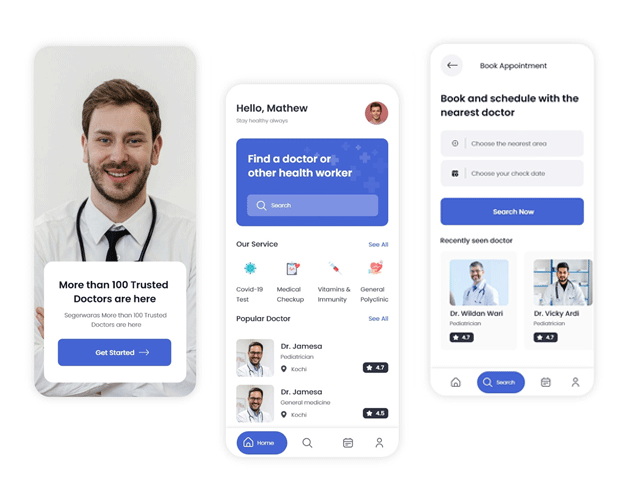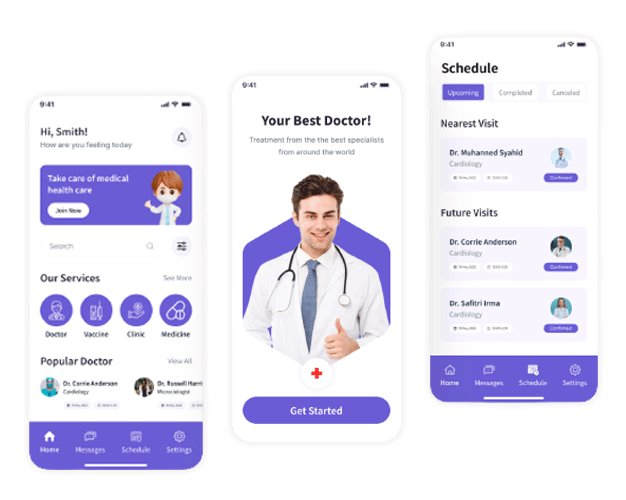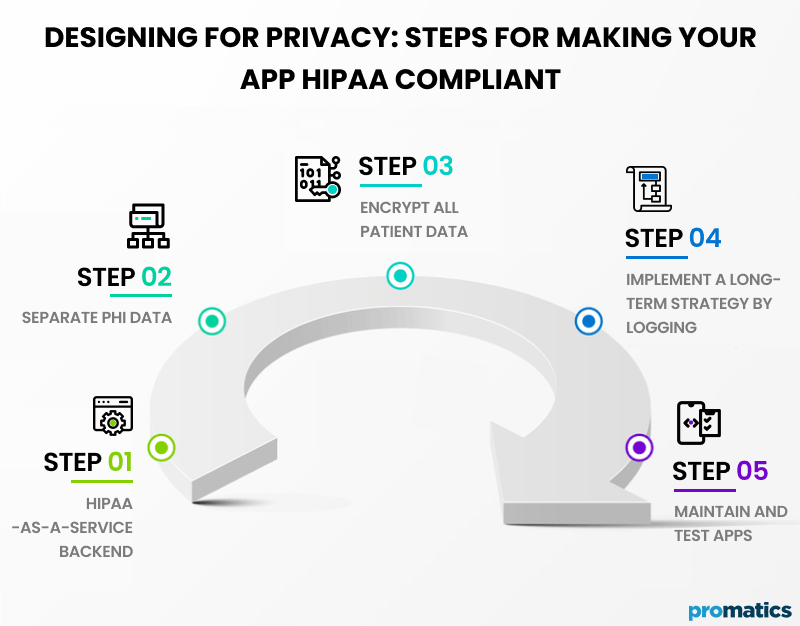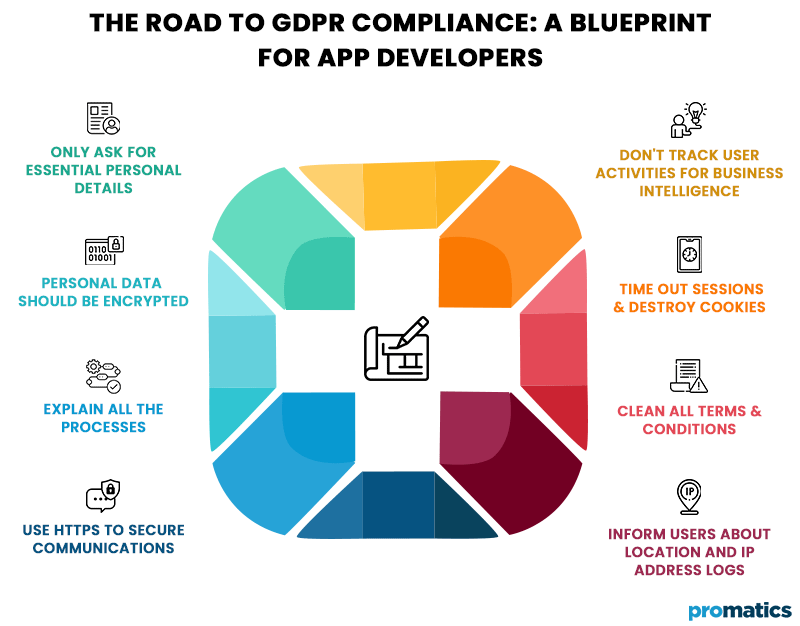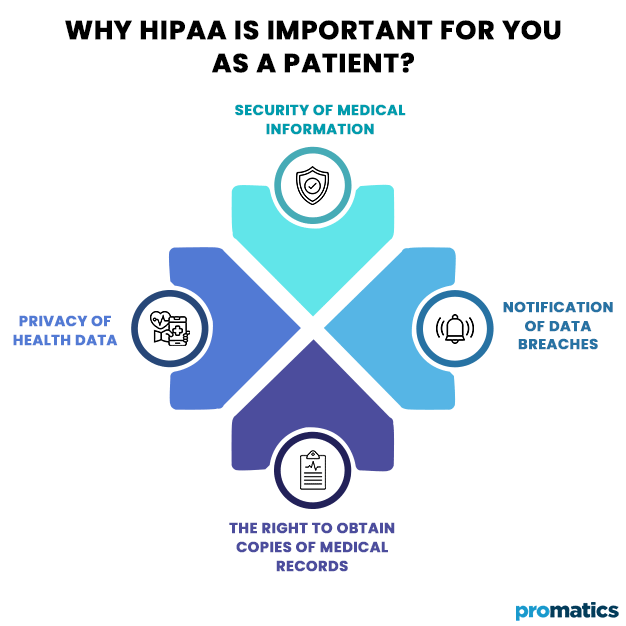Keeping User Data Safe: Essential Requirements for Creating a HIPAA and GDPR Compliant App
Now technology dominates our lives. So it’s common for companies to worry about the privacy and security of personal data. To reduce this worry, the US & EU introduced two of the most significant regulations protecting sensitive personal data, which are the “Health Insurance Portability and Accountability Act (HIPAA) and General Data Protection Regulation (GDPR).”
However, you must know how to make your mobile HIPAA and GDPR-compliant. In this article, we will briefly explain HIPAA & GDPR definitions and the guidelines to make an app HIPAA & GDPR compliant. So let’s get started.
What Is HIPAA & GDPR?
Health Insurance Portability and Accountability Act (HIPAA):
If you’re developing healthcare software for the US market, HIPAA is the law you need to know about. As difficult as creating mHealth applications, ensuring they are HIPAA compliant is much more challenging.
HIPPA law was created in 1996. It saves healthcare costs and offers ongoing health insurance coverage to jobless or job-changing individuals. However, this law is essential to protect your app from data fraud.
Smartphones and gadgets have recently gained popularity in healthcare settings. These devices connect patients and physicians and monitor health status. So smartphone applications that handle, receive, or transfer sensitive data must comply with HIPAA. For this reason, building mHealth apps that adhere to HIPAA standards is so common right now.
Before beginning work on a medical app for the US market, it’s crucial to determine what kinds of data will be kept and sent by the app. We may categorize data into two categories:
PHI (Protected Health Information)
Bills from physicians, emails from nurses, MRI and blood test results, and other records containing personal health information are all examples of PHI. It also includes geolocation data that places a person inside an area smaller than a state.
CHI (Consumer Health Information)
CHI monitors the information from the fitness tracker—for example, calorie expenditure, heart rate, and step count. So your software must adhere to HIPAA regulations if it handles, stores, or transmits protected health information.
General Data Protection Regulation (GDPR)
GDPR became applicable on May 25, 2018. Its purpose is to guarantee that individuals are in charge of their data. The General Data Protection Regulation (GDPR) is a significant improvement over the EU’s prior data protection law and the most substantial change in this area of law in the last 20 years.
This new rule intends to alter how all sectors of the economy manage private information by placing individuals in control of their data processing. The public may now control who sees and uses their data.
After issuing these new rules, companies may no longer fix the damage and issue apologies. They also need supervision or simple disclosures to collect and utilize consumer data. So from day one, companies must show that they comply with GDPR and make efforts to secure personal data.
How to Make an App HIPAA Compliant?
Four guidelines must be met for an app development project to comply with HIPAA:
a.) Privacy rule
b.) Enforcement rule
c.) Security rule
d.) Breach notification rule
The security policy is the primary guideline for any developer working on medical apps, specifying both technological and physical safeguards.
Technological Safeguards:
The primary goal of technical protection is the complete and total encryption of all data during transmission and while kept on devices and servers. Technical safeguards include:
a.) User identification
b.) Encrypted and decrypted the ePHI system
c.) Automatic logoff
d.) Emergency access procedures
Moreover, you should remember that you don’t obtain or retain more data than necessary or longer than necessary for your task. You shouldn’t send any PHI data through push notifications because it can leak your saved backups or log information.
Controls for Audits
Apps that comply with HIPAA must monitor and track ePHI activities.
Integrity
The HIPAA-compliant software must have safeguards to prevent ePHI from being accidentally altered or damaged. HIPAA requires data integrity to ensure it has not been damaged, lost, or interfered with.
Authentication of Persons
A user’s identity must be verified before accessing any protected areas of a system or app.
Security of Transmission
The transmission of electronically protected health information (ePHI) via the internet or any communication network requires special precautions to prevent tampering.
Physical Safeguards:
Physical safeguards mean protecting the server side, data transfer networks, and user endpoints like iPhones and other iOS and Android devices that might be lost or stolen.
To enhance your app’s security, you can use regular authentication. Another great thing is to increase security without negatively impacting your app’s user experience, which is fingerprint authentication. If you lose your device, these safeguards will secure your data.
Moreover, you should use PHI-free memory cards on your mobile devices due to the lack of secure authorization, and memory cards provide a security risk. With HIPAA-compliant software with trustworthy partners, you need more than just a collection of technical resources like libraries and third-party services. Data in the software you design should be encrypted, but you should also take precautions to prevent its disclosure, even if the server or device is hacked.
Administrative Safeguards:
Administrative safeguards are responsible for developing, implementing, and maintaining security measures. Their purpose is to secure ePHI.
a.) Information Access Management is essential in HIPAA-compliant app development to restrict access to non-essential electronic protected health information (ePHI).
b.) Users should only be allowed to access ePHI related to their job function, not patient-specific ePHI.
c.) Employee training should include ePHI security policies.
d.) In the case of a breach, it is critical to have a strategy in place to inform anyone who may be impacted promptly.
Now let’s move into the next section of how you can create your medical app HIPAA complaint.
Guidelines for Developing a Medical App That Complies with HIPAA
HIPAA-compliant chatbots and doctor’s appointment apps will be the norm by 2024. Let’s review all the processes to make your custom-built software HIPAA-compliant.
HIPAA-As-A-Service Backend
Nowadays, applications link to web apps. The same holds for healthcare applications, even if they use cloud services that must be HIPAA compliant. Luckily, you’ll find several options that all are HIPAA-compliant backends. The most trustworthy cloud services are:
i.) Truevault
ii.) AWS
iii.) Google Compute Engine
iv.) Aptible
v.) Datica
Separate PHI Data
While you design HIPAA-compliant software, store all patient health data in a different database. It’ll reduce your work to repeatedly encrypt and decrypt the app’s data, which might make app performance slower.
Encrypt All Patient Data
HIPAA doesn’t support specific encryption or decryption protocols for safety purposes. HIPAA requires all PHI data to be secured at rest and in sync. Such encryption ensures the safety of data transmission and foils hacking attempts. So you can use open-source like
a.) AES 256-bit encryption
b.) OpenPGP
c.) S/MIME
Implement a Long-Term Strategy by Logging
Because of your software’s ever-changing nature, you’ll need to implement measures for ongoing HIPAA compliance monitoring. You will need to monitor access to PHI, identify security problems, routinely analyze the efficacy of security measures, and evaluate the possible hazards of compromising e-PHI.
Maintain and Test Apps
You must test your apps after every alteration. You should run static and dynamic tests on your application and double-check the documentation with an expert.
Your application needs ongoing maintenance to be safe. Resources, tools, and frameworks for app development and security are updated often. A HIPAA-compliant mHealth app must be updated to avoid security risks.
Guidelines for Developing a Mobile App That Complies with GDPR
The GDPR defines “Personal Data” as any information about an individual. This information covers everything from an individual’s name and address to a user’s browser cookie via an analytics monitoring provider. You should think about how you’ll collect and retain users’ IP addresses and device IDs in addition to the more conventional “personal identifiers” like names and email addresses. After establishing the fundamentals, you may go on to the implementation and regulation stages. So here, we provide you with some steps to make your mobile app GDPR-compliant.
Only Ask for Essential Personal Details
The most crucial aspect of app privacy and data security is storing as little user data as possible. It may be a person’s name, birth date, address, and country. However, some organizations may not achieve specific information in most circumstances. This information may be vital to the app’s smooth operation.
So whether you require a lot of data or only a few facts, developers and app owners must decide which data is essential and only request that much. To get the most information, avoid the urge to use the app.
Personal Data Should Be Encrypted
Data encryption encodes data into a code only the password or key can read. If your mobile app collects and stores user data, it must be protected using strong encryption methods like hashing. A data breach can happen if you don’t encrypt all the personal data. So, as a developer, you should encrypt and hash all personal data like names, phone numbers, addresses, etc. If a breach occurs, this prevents data extraction. You must inform your users that you encrypt their personal information as part of your service.
Explain All the Processes
The GDPR requires the app’s user interface to state how user data will be used clearly. Also, it must get an explicit user agreement before collecting sensitive information. When installing your app, users must know how you will use their data in each area and for how long.
Use HTTPS to Secure Communications
Not utilizing HTTPS in our modern, privacy-conscious digital environment is a huge mistake. If your app doesn’t need authentication, you may think you don’t need HTTPS either. Yet there’s a strong probability you missed specific details.
For example, practicing gathering user information through an app’s “Contact Us” page is common. You can face data loss or hacking if you don’t encrypt those data. So you must install SSL correctly to be immune to the weaknesses associated with SSL protocols.
Don’t Track User Activities for Business Intelligence
Several e-commerce organizations use apps to monitor user searches and purchases to study customer behaviour. Users should be allowed to agree or refuse to track since their preferences and interests are monitored for commercial purposes. Users must know why and how long their data will be stored if they choose this monitoring. It would help if you also considered using encryption here.
Time Out Sessions & Destroy Cookies
It’s essential to be transparent with users about whether or not you’re utilizing cookies. Additionally, provide people with the option to either accept or decline cookies.
In addition, cookies must be deleted after a user logs out or after an extended period of inactivity. You should also set a session timeout to log users out and remove their cookies after a specific time.
Clean All Terms & Conditions
Your app’s users will benefit most if the terms and conditions are written in plain English that can be readily understood. After uninstalling your app, you should ensure that all terms & conditions should be cleaned.
Inform Users about Location and IP Address Logs
An IP address or geolocation might be a parameter in your mobile app’s authorization and access management system. This data is then stored in their system for future reference in the event of an attempted authentication bypass. In addition to informing users how long their logs will be kept, it is vital to clarify this point. In these logs, you should never record passwords and other private information.
Why Is HIPAA Important?
The HIPAA is essential to patients and medical professionals. It safeguards sensitive data and regulates its handling and exchange. The legislation governs confidentiality and privacy, including who may exchange information and how. So, any firm developing a web or mobile health data app should know whether it must be HIPAA compliant.
For Patients:
Most patients benefit from HIPAA. However, this is widely debated. Most people know the term, but only some can explain its significance. Patients must understand four essential points of HIPAA to benefit entirely from their rights and protections under the law.
a.) Privacy of health data
b.) Security of medical information
c.) Notification of data breaches
d.) The right to obtain copies of medical records
For Health Providers
HIPAA sets requirements for medical organizations to safeguard PHI and enhance healthcare management. These regulations mainly prevent data theft. They require organizations to inform patients of breaches and prohibit PHI forwarding without authorization. HIPAA compliance is essential for many customized healthcare software development projects since breaches might result in penalties.
Risk & Penalties
HIPAA compliance software standards are essential, so it’s best to be prepared and know what to anticipate if an app doesn’t comply. Severe violations of HIPAA rules include data loss, unauthorized access to private information, and the disclosure of protected health information. Administrative penalties may total up to $1.5 million per year, with a minimum threshold of $100 per infraction and a maximum of $50,000.
Why Can’t You Ignore GDPR?
Some individuals comply with GDPR because of the legal consequences, while others worry about the financial and reputational repercussions. If a data breach happens, EU legislation declares that playing games with user data and disregarding GDPR may result in heavy penalties of up to €20 million or 4% of annual sales, whichever is larger! Although GDPR for mobile apps does not need any significant changes to your app, it will indeed affect your company and the way you collect and manage data.
Conclusion
The healthcare sector and digital health apps must apply these two regulations to protect their data. So it’s vital to have the ins and outs to make them GDPR and HIPPA-compliant. You can take help from an expert. We hope this article gave you the proper guidelines for making your apps GDPR and HIPPA-compliant and solving all your necessary queries.
Still have your concerns?
Your concerns are legit, and we know how to deal with them. Hook us up for a discussion, no strings attached, and we will show how we can add value to your operations!
